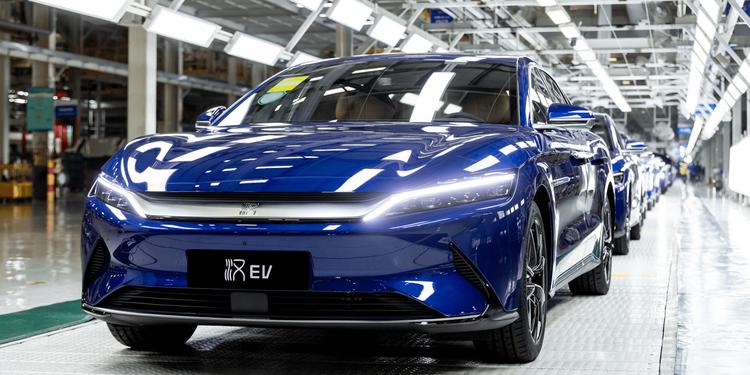The sales of new energy passenger vehicles reached 272,000 units in February, the best February sales ever with car delivery up 180.5% year on year (YoY) and down 22.6% month on month (MoM), according to the China Passenger Car Association.
The EV penetration rate, defined as EV sales divided by vehicle sales, was 21.8% in February, 13.7 percentage points higher than 8.1% in February 2021 and 16.6% in January 2022.
Sales dissection
The flourishing EV market contributed to the stellar sales of a few auto brands. Unparalleled sales growth of BYD's battery vehicles and hybrid vehicles cemented its status as the new energy vehicle leader.
Traditional auto companies represented by SAIC and GAC are rising to prominence in the sector. Specifically, there were five manufacturers whose retail sales exceeded 10,000 units, including BYD at 86,669, 28,713 of SAIC-GM-Wuling, 23,200 of Tesla China, 13,697 of Geely Auto and 10,271 of Chery Auto.
The leading wholesales figure is better than retail sales. The five manufacturers above also present generated wholesale sales exceeding 10,000 units, including 87,473 for BYD, 56,515 for Tesla China, 26,046 for SAIC-GM-Wuling, 14,285 for Geely Auto and 10,271 for Chery Automobile. Except for Tesla, these companies saw a growth of five to seven times compared to a year ago. (The charts below indicates the retail sales of various NEV brands)
China's EV-making ''New Forces'' brands such as Li Auto, NETA, XPeng continued their solid performance. In particular, the three companies have more than doubled their figures on a year-on-year basis. Leapmotor also increased car sales by more than five times year on year. Among the joint venture brands in China, Volkswagen sold 11,916 new energy vehicles by wholesale, accounting for 58% of all NEV sales by JV automakers.

EV battery market updates
In terms of the EV battery market, China's power battery yield was 31.8GWh, jumping 236.2% YoY and 7.1% MoM in February?. The output of the ternary battery was 11.6GWh, accounting for 36.6% of the total production and growing by 127.2% YoY; The yield of lithium iron phosphate battery was 20.1GWh, accounting for 63.1% of the total output, surging by 364.1% YoY and 6.7% MoM.
The installment volume of EV batteries in China was 13.7GWh, growing by 145.1% YoY and decreasing by 15.5% MoM, while that of the ternary battery was 5.8GWh, up 75.6% YoY and down 19.9% MoM. A 7.8GWh of lithium iron phosphate battery was installed, skyrocketing 247.3% YoY, and sliding 12.3% MoM.
Charging infrastructure
Based on the data compiled by the China EV Charging Infrastructure Promotion Alliance, an industry association, the number of public charging piles in February increased by 36,000 units compared to the previous month, up 44.9% YoY.
As of February 2022, there were 1.213 million public charging piles, including 496,000 direct current (DC) charging piles, 717,000 alternating current (AC) charging piles and 589 AC and DC integrated charging piles. From March 2021 to February 2022, an average of 31,000 public charging piles were added every month.
In a nutshell
In February, China's EV market experienced another month of high growth in overall car sales, battery yield, and infrastructure build-up. But signs of exuberance aren't everywhere. BYD grabbed the most market share, followed by some EV brands like NIO and Great Wall Motor’s ORA, which seem to be losing steam, though. Besides, the EV market faces a prolonged threat of surging costs for raw materials. As a result, various EV brands adjusted prices accordingly. Last but not least, China is trying to contain a new wave of Covid-19 outbreak, with measures like lockdowns and travel restrictions imposed on a few of China's largest EV markets like Shanghai and Shenzhen. The production and sales of EVs in March could suffer




